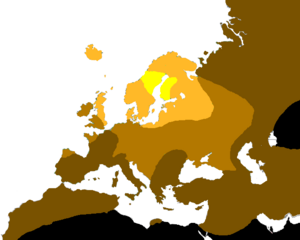- Joined
- May 2, 2006
- Messages
- 20,522
- Reaction score
- 57
yesterday, while i was in the underground, a strange fact hit me : there was only one woman with red hair in the train. while we brunettes seem to take over the world with all our shades, from dark brown to chestnut, and the blondes don't let you forget them, i find that red hairs are really rare nowadays. i know of only two people at my university with red hair, one being my friend and who recently went back to her natural brown because she was tired of her roots turning into a grossy yellow. so, not only they're rare, but some of them are what we could call "false" red hairs (don't get me wrong, i love having the possibility of getting my hair dyed !). i would love to see more red heads, the color is so gorgeous and vibrant under the sun ! i am proud myself of the red highlights my hair seems to take during the sunny months.
doing a bit of googling i have learned (though i'm lost quickly in genetics) that it has to do with genes, actually the combination of two, and the combination allowing people to have red hair is rare.
allow me to quote wikipedia on that one.
There are two types (three subtypes) of pigment that give hair its color: Eumelanin & Pheomelanin, Eumelanin is black and brown while Pheomelanin is red. The amount of eumelanin in hair determines the darkness of its color. A low concentration of brown eumelanin in the hair will make it blonde, whereas more brown eumelanin will give it a brown color. Much higher amounts of black eumelanin will result in black hair, and a low concentration of black eumelanin in the hair will make it gray. All humans have pheomelanin in their hair. Pheomelanin is more chemically stable than black eumelanin, but less chemically stable than brown eumelanin, so it breaks down more slowly when oxidized. This is the reason bleach will cause darker hair to turn reddish brown during the artificial coloring process. As the pheomelanin continues to break down, the hair will gradually become orange and, later, yellow and then white.

Light Hair Distribution Map
of indigenous populations
according to
anthropologist
Peter Frost
1-19%
light color hair
no light color hair
20-49%
light color hair
50-79%
light colored
hair
80%+
light
colored hair
The genetics of hair color are not yet firmly established.
According to one popular theory, at least two gene pairs control human hair color. One gene, which is a brown/blond pair, has a dominant brown allele and a recessive blond allele. A person with a brown allele will have brown hair; a person with no brown alleles will be blond. This also explains why two brown-haired parents can produce a blond-haired child. The other gene pair is a not-red/red pair, where the not-red allele (which suppresses production of pheomelanin) is dominant and the allele for red hair is recessive. Since the two gene pairs both govern hair color, a person with two copies of the red-haired allele will have red hair, but it will be either auburn or bright reddish orange depending upon whether the first gene pair gives brown or blond hair, respectively.
The two-gene model does not account for all possible shades of brown, blond, or red (for example, platinum blond versus dark blond/light brown), nor does it explain why hair color sometimes darkens with age. Several gene pairs control the light versus dark hair color in a cumulative effect. Therefore, the more of these that are dominant, the darker the hair will be.
In the map to the right, "light" hair refers to blond, red, and light brown.
Black hair
Black hair is the darkest and most common color of human hair. Black hair is found in people of all ethnicties. Some argue that there is no black hair in Europe, but it is quite common in Southern Europe. People have black hair in Asia, but usually in the Philippines. It has large amounts of eumelanin and is less dense than other hair colors. It can be a very dark brown or complete black. Black hair is known to be the shiniest out of all other hair colors.[2]
Brown hair
Brown hair is the second most common hair color (after black hair) and is also found all over the world (mostly European, Middle Eastern, African, or some Native American heritage). It is characterized by higher levels of the dark pigment eumelanin and lower levels of the pale pigment phaeomelanin. Of the two types of eumelanin (black and brown), brown-haired people have brown eumelanin. Brown-haired people usually have medium-thick strands of hair. Brown haired people can range highly in skin and eye color. A brown-haired male may be called a brunet, though this usage is relatively uncommon; a brown-haired female may be called a brunette. Often, dark brown hair is confused with black. However, on closer inspection it is clearly a shade of brown.
Blonde hair
Blonde hair is a relatively rare human phenotype due to its association with recessive genes, occurring in approximately 2% of the World population.
Blonde hair ranges from nearly white (platinum blonde, tow-haired--though this shade is extremely rare) to a dark golden blonde. Strawberry blonde (found predominantly in the British Isles) is an especially rare type (the most pheomelanin): a mixture of blonde and red hair. Blonde hair can have almost any proportions of pheomelanin and eumelanin, but both only in small amounts. More pheomelanin creates a more golden blonde color, and more eumelanin creates an ash blonde. The most pheomelanin creates a strawberry blonde. Males with this hair color are blond; females are blonde.
Red hair
Red hair is the least common hair color. It ranges from vivid strawberry shades to deep auburn and burgundy. Celtic heritage is common with red hair. Red hair is caused by a mutation of the Mc1r gene and believed to be recessive.[3] Red hair has the highest amounts of pheomelanin and usually low levels of eumelanin.
Source
doing a bit of googling i have learned (though i'm lost quickly in genetics) that it has to do with genes, actually the combination of two, and the combination allowing people to have red hair is rare.
allow me to quote wikipedia on that one.
There are two types (three subtypes) of pigment that give hair its color: Eumelanin & Pheomelanin, Eumelanin is black and brown while Pheomelanin is red. The amount of eumelanin in hair determines the darkness of its color. A low concentration of brown eumelanin in the hair will make it blonde, whereas more brown eumelanin will give it a brown color. Much higher amounts of black eumelanin will result in black hair, and a low concentration of black eumelanin in the hair will make it gray. All humans have pheomelanin in their hair. Pheomelanin is more chemically stable than black eumelanin, but less chemically stable than brown eumelanin, so it breaks down more slowly when oxidized. This is the reason bleach will cause darker hair to turn reddish brown during the artificial coloring process. As the pheomelanin continues to break down, the hair will gradually become orange and, later, yellow and then white.

Light Hair Distribution Map
of indigenous populations
according to
anthropologist
Peter Frost
1-19%
light color hair
no light color hair
20-49%
light color hair
50-79%
light colored
hair
80%+
light
colored hair
The genetics of hair color are not yet firmly established.
According to one popular theory, at least two gene pairs control human hair color. One gene, which is a brown/blond pair, has a dominant brown allele and a recessive blond allele. A person with a brown allele will have brown hair; a person with no brown alleles will be blond. This also explains why two brown-haired parents can produce a blond-haired child. The other gene pair is a not-red/red pair, where the not-red allele (which suppresses production of pheomelanin) is dominant and the allele for red hair is recessive. Since the two gene pairs both govern hair color, a person with two copies of the red-haired allele will have red hair, but it will be either auburn or bright reddish orange depending upon whether the first gene pair gives brown or blond hair, respectively.
The two-gene model does not account for all possible shades of brown, blond, or red (for example, platinum blond versus dark blond/light brown), nor does it explain why hair color sometimes darkens with age. Several gene pairs control the light versus dark hair color in a cumulative effect. Therefore, the more of these that are dominant, the darker the hair will be.
In the map to the right, "light" hair refers to blond, red, and light brown.
Black hair
Black hair is the darkest and most common color of human hair. Black hair is found in people of all ethnicties. Some argue that there is no black hair in Europe, but it is quite common in Southern Europe. People have black hair in Asia, but usually in the Philippines. It has large amounts of eumelanin and is less dense than other hair colors. It can be a very dark brown or complete black. Black hair is known to be the shiniest out of all other hair colors.[2]
Brown hair
Brown hair is the second most common hair color (after black hair) and is also found all over the world (mostly European, Middle Eastern, African, or some Native American heritage). It is characterized by higher levels of the dark pigment eumelanin and lower levels of the pale pigment phaeomelanin. Of the two types of eumelanin (black and brown), brown-haired people have brown eumelanin. Brown-haired people usually have medium-thick strands of hair. Brown haired people can range highly in skin and eye color. A brown-haired male may be called a brunet, though this usage is relatively uncommon; a brown-haired female may be called a brunette. Often, dark brown hair is confused with black. However, on closer inspection it is clearly a shade of brown.
Blonde hair
Blonde hair is a relatively rare human phenotype due to its association with recessive genes, occurring in approximately 2% of the World population.
Blonde hair ranges from nearly white (platinum blonde, tow-haired--though this shade is extremely rare) to a dark golden blonde. Strawberry blonde (found predominantly in the British Isles) is an especially rare type (the most pheomelanin): a mixture of blonde and red hair. Blonde hair can have almost any proportions of pheomelanin and eumelanin, but both only in small amounts. More pheomelanin creates a more golden blonde color, and more eumelanin creates an ash blonde. The most pheomelanin creates a strawberry blonde. Males with this hair color are blond; females are blonde.
Red hair
Red hair is the least common hair color. It ranges from vivid strawberry shades to deep auburn and burgundy. Celtic heritage is common with red hair. Red hair is caused by a mutation of the Mc1r gene and believed to be recessive.[3] Red hair has the highest amounts of pheomelanin and usually low levels of eumelanin.
Source



































